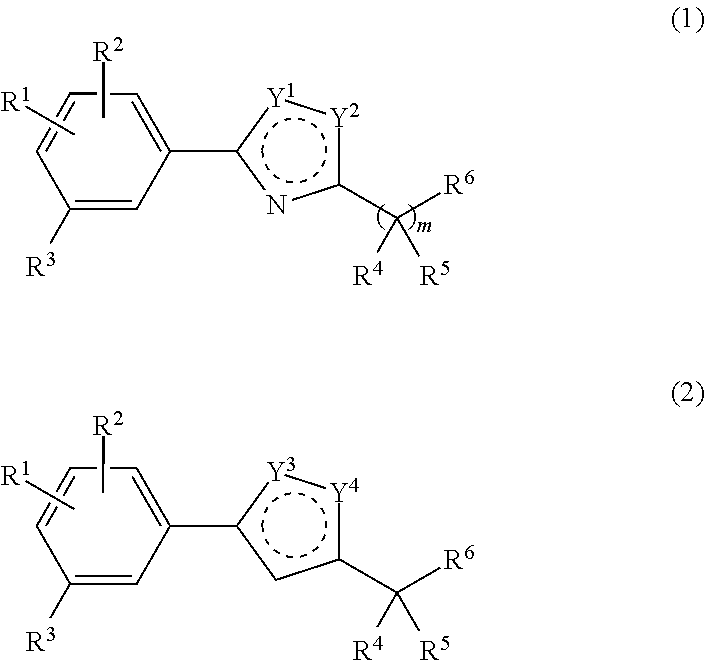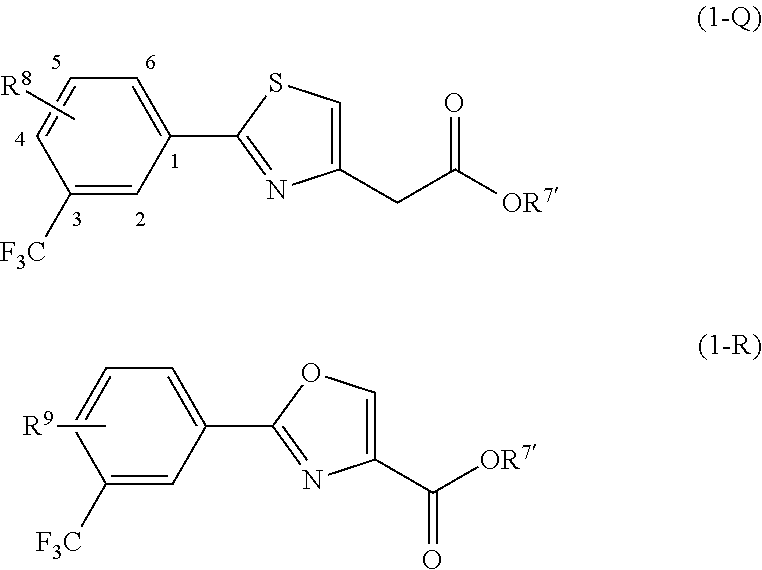Compositions and methods for modulating retinol binding to retinol binding protein 4 (RBP4)
a technology of retinol and binding protein, which is applied in the field of compositions and methods for modulating retinol binding to retinol binding protein 4 (rbp4), can solve the problems of gradual loss of vision, severe damage to the central vision, and blindness in children
- Summary
- Abstract
- Description
- Claims
- Application Information
AI Technical Summary
Benefits of technology
Problems solved by technology
Method used
Image
Examples
example 1
Methyl 2-(2-(3,5-bis(trifluoromethyl)phenyl)thiazol-4-yl)acetate
[0150]
[0151]To a sealed vial was added 3,5-bis(trifluoromethyl)benzothioamide (60 mg, 0.22 mmol), methyl-4-chloroacetoacetate (33 mg, 0.22 mmol) and ethanol (1 mL). After stiffing at 180° C. in the microwave for 10 minutes, the volatile reagents were removed under reduced pressure. The compound was purified via silica gel chromatography (0%-35% ethyl acetate / hexanes) to give the desired product.
example 2
2-(2-(3,5-Bis(trifluoromethyl)phenyl)thiazol-4-yl)acetic acid
[0152]
[0153]To a vial was added methyl 2-(2-(3,5-bis(trifluoromethyl)phenyl)thiazol-4-yl)acetate (78 mg, 0.22 mmol), LiOH.H2O (26 mg, 0.66 mmol) and THF:MeOH:H2O (10:1:10, 1 mL). The reaction was stirred at ambient temperature for 4 h and then quenched with 10% Citric Acid and extracted with EtOAc (3×). Organic layers were combined and washed with H2O, brine and dried over MgSO4. The volatile organic solvents were removed under reduced pressure. The product was recrystallized from EtOH / H2O.
example 3
Methyl 2-(3-(3,5-bis(trifluoromethyl)phenyl)-1,2,4-oxadiazol-5-yl)acetate
[0154]
[0155]To a vial was added 3,5-bis(trifluoromethyl)benzamidoxime (500 mg, 1.84 mmol), DIPEA (641 μL, 3.86 mmol) and CH2Cl2 (15 mL), and the mixture was cooled to 0° C. in an ice / water bath. After 10 min of immersion, methyl malonyl chloride (236 μL, 2.21 mmol) was added, and the reaction was removed from the cooling bath and stirred at ambient temperature overnight. The reaction was diluted with water (10 mL) and then a standard aqueous acidic workup using EtOAc, 10% Citric acid, and brine was employed. The volatile organic solvents were removed under reduced pressure. The reaction mixture was dissolved in dioxane (3 mL), and catalytic TBAF was added to the reaction mixture in a microwave vessel. The reaction mixture was heated to 150° C. for 10 min Upon cooling to ambient temperature, the volatile organic solvents were removed under reduced pressure. The organic layer residue was dissolved in DMSO, and th...
PUM
| Property | Measurement | Unit |
|---|---|---|
| Current | aaaaa | aaaaa |
| Digital information | aaaaa | aaaaa |
| Molar density | aaaaa | aaaaa |
Abstract
Description
Claims
Application Information
 Login to View More
Login to View More - R&D
- Intellectual Property
- Life Sciences
- Materials
- Tech Scout
- Unparalleled Data Quality
- Higher Quality Content
- 60% Fewer Hallucinations
Browse by: Latest US Patents, China's latest patents, Technical Efficacy Thesaurus, Application Domain, Technology Topic, Popular Technical Reports.
© 2025 PatSnap. All rights reserved.Legal|Privacy policy|Modern Slavery Act Transparency Statement|Sitemap|About US| Contact US: help@patsnap.com



